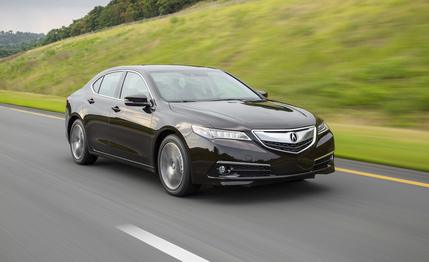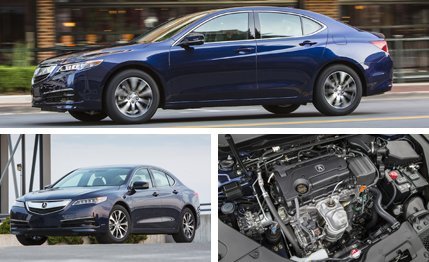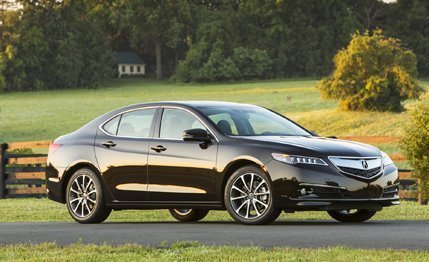
 First Drive Review
First Drive Review
The first-generation TSX sedan was everything a luxury Honda—so, an Acura—should be. Its rev-happy four-cylinder and willing chassis zinged our hearts, as did the contemporary, V-6–powered third-generation TL. Both cars’ appeal waned for the 2009 model year, when Acura’s bid for increased mainstream appeal resulted in softer and stranger-looking replacements; today, sales pressure from the RLX above and the ILX below have killed them off entirely. The 2015 TLX is tasked with replacing both.
The move makes some sense. While the TSX roughly matched the size of the entry-luxury standard bearer, the BMW 3-series, the TL was a tweener. For the TLX, Acura carried over the TL’s 109.3-inch wheelbase but chopped the overhangs by 3.7 inches total and made the car a full inch narrower. The result is a wonderfully right-size package that feels as roomy as the current F30 3-series and the new Mercedes-Benz C-class. Acura claims the body shell is all-new and that its materials mix includes 47 percent high-strength steel. Stiffness is up relative to the TL’s, but weight is kept to near-TSX levels and the new car abandons Acura’s techno-iron-chicken look for a more tailored and handsome appearance.
The TLX’s base 2.4-liter is the same sweet four-pot found in the Honda Accord—right down to the block, direct fuel-injection system, and i-VTEC valve timing and intake cam-phasing tech—but with its own dual-stage intake manifold and higher 11.6:1 compression ratio. It also requires premium fuel. The alterations extract 17 additional ponies for 206 horsepower at 6800 rpm; torque is unchanged from the Honda at 182 lb-ft, although its 4500-rpm peak occurs 600 revs higher. The TLX’s output tops the old TSX’s port-injected four-cylinder by 5 horsepower and 10 lb-ft.


The four is hitched exclusively to a new, in-house-designed eight-speed dual-clutch automatic. Unusually and in what Acura calls a first, a torque converter is fitted in place of the flywheel to deliver off-the-line torque multiplication, enable smoother takeoffs from a stop, and damp vibrations. It works. The off-the-line jerkiness present in nearly every transmission of this type—even the Volkswagen Group’s version suffers a little—is nowhere to be found. Once underway, the converter quickly locks up for proper, ultraquick-shifting dual-clutch feel. The four-cylinder car gets Acura’s agility-enhancing Precision All-Wheel Steer (P-AWS) four-wheel steering as standard, as does the front-drive V-6 model.
The 3.5-liter V-6 also traces its roots to other current Honda and Acura products, but it incorporates a beefier starter to support the Super Handling All-Wheel Drive (SH-AWD) model’s standard engine stop-start feature. It also has Honda’s Variable Cylinder Management, which drops three cylinders during low-load driving to save fuel, as well as a new block casting to facilitate the only transmission choice, a ZF-sourced nine-speed automatic. Acura totally reworks the ZF unit, specifying a new case compatible with SH-AWD, unique ratios, and its own shift logic. As a bonus, V-6 models get cool push-button transmission controls in place of the dual-clutch’s traditional shift lever; they wouldn’t look out of place in a Ferrari. Output from the V-6 is strong—albeit not quite BMW 335i–strong—at 290 horsepower and 267 lb-ft of torque, 10 and 13 more than the old TSX’s optional six.


Slide behind the TLX’s meaty three-spoke steering wheel, and a clean gauge cluster with sharp white-on-black dial faces stares back at you. A red starter button sits off to the right of the wheel. The aesthetic is pure Honda in the best way possible, an impression carried further by the clean dashboard design, low cowl, and wide, comfortable seats. The dual central display arrangement is bizarre, just as it is in a rash of recent Honda/Acura products. The lower touch screen handles audio and some climate-control functions, while the upper, non–touch screen (controlled by a knob and hard buttons located under the lower display) manages the same stuff, plus navigation. The graphics and resolutions of the displays don’t quite match; one screen would do the job just fine.